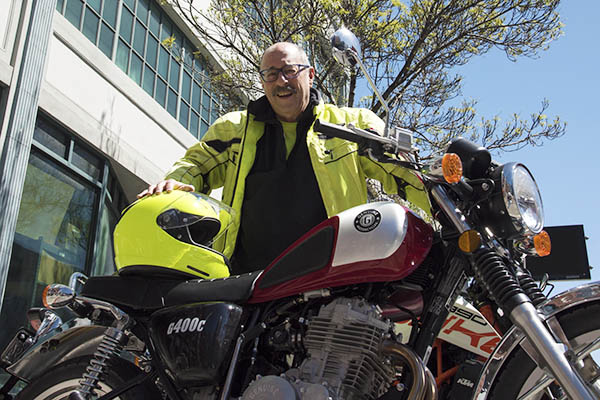
This is one of those blogs for which I could have used any of several titles. The Real Deal got the nod, as this is indeed the real deal…a genuine (pardon the pun) motorcycle. Another contender was The Streets of San Francisco, like that Karl Malden and Michael Douglas show 30 years ago. And yet another was We Are Living In Interesting Times (read on, and you’ll see what I mean).
Anyway, enough of the trip down memory lane and alternative blog titles. I made a few memories of my own yesterday, riding around downtown San Francisco around good buddy Lunchbox’s San Francisco Scooter Centre. Barry is the guy who owns and runs the dealership, but Lunchbox is the guy in charge. He’s about a year old now (I’ve known him since he was a pup), and he’s a cool 82 lbs. After checking in with Lunchbox, I visited with Barry for a bit. I always like coming up here. I like Lunchbox, I like the city, I like the San Francisco Scooter Centre, and I like Barry.

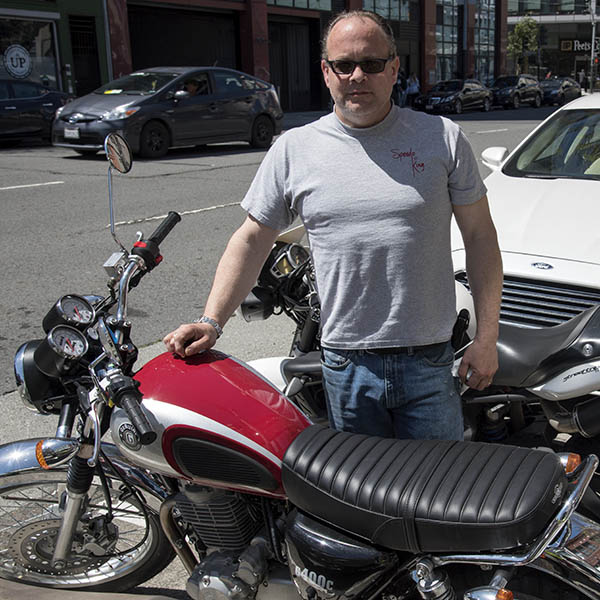
Barry and I had a great taco lunch downtown, we talked about the motorcycle market, and we swapped stories about a couple of our other common interests. Then it was time to get on the G400c. Barry tossed me the keys and the bike’s registration, and told me to have fun. Being a guy who aims to please, I did as I was told. It was easy on the Genuine.
So let me tell you about the Genuine G400c. The first thing I noticed was that it’s a motorcycle. A real motorcycle. Tear drop gas tank (where the gas actually goes), a tach and speedo that look like a tach and speedo should, and a long, low, flat seat (good for moving around on when necessary, carrying a passenger, and strapping on soft luggage for longer trips). Wire wheels. Chrome fenders. Chrome handlebars that put the controls in comfortable reach. It all came together the way it should. Yessiree, this is a motorcycle that is visually appealing. None of that Ricky Racer, low bar face on the tank, angry Ninja insect, or giraffesque ADV wannabe silliness or styling. This is a motorcycle that looks like a motorcycle should.
The next thing I noticed was that the G400c was easy to throw a leg over. It’s been a while since I’ve been on a bike where I could say that. I’ll say more on this in a bit.
And another thing I noticed was that the bike sounds like a motorcycle. A real motorcycle. A Genuine motorcycle. I like that, too. I had my big Nikon with me (the D810) and I grabbed a video of the startup sequence…
This bike sounds good. It has a nice, deep, throaty rumble. The skyscrapers I darted between in downtown San Francisco amplified the exhaust note, and the reverberations were intoxicating. There’s something undeniably cool about riding a nimble, throaty motorcycle in a city. It would have been cool to grab more video of myself riding around San Francisco, but I’m not as talented as Joe Gresh in that regard and besides, I was having too much fun. You can have a great ride or you can make a great video. Unless you’re Joe Gresh, you can’t do both at the same time.
So back to that nimble thing. You’re reading something written by a guy who thinks that somewhere in the 1970s and the 1980s the wheels came off the wagon here in the US with regard to motorcycle size and complexity, and until very recently, things have continued to get nuttier as the years have gone by and advertising guys (who are supposed to be creative people) kept defaulting to bigger has to be better. My thoughts are in synch with most of the rest of the motorcycle world (not the aforementioned advertising gurus) in that I think a 250cc is the perfect size. A 400cc single is even better, especially if it comes in a 250cc-sized package, and that’s what the G400c is.
I don’t know the Genuine’s weight. I could find it in a few seconds with a Google search, but I don’t need to. I know what I need to know from my ride, and that’s this: The G400c is light and it’s nimble, and that’s all the spec I need. Hell, you can’t trust what most of the manufacturers tell you about their bikes’ weights, anyway. And even if you could believe their numbers, what really matters is where a bike’s center of gravity is located. Make it too high, and a motorcycle will feel unwieldy regardless of its weight. Make it low, though, and a bike becomes flickable, agile, nimble, and just plain fun to ride. That’s what this machine is. I had fun splitting lanes and braaapping around downtown San Francisco. The G400c is perfect for that, but that’s not the only arena in which I see it excelling. I think the G400c would be a great bike for a Baja ride, too. Someday. We’ll see.
Next up: Seat height. It’s the same story here, folks. Like I said earlier, I could throw my leg over the seat without having to take a yoga class or do any stretching exercises, and you know what? That’s a good feeling. The saddle is low enough to make getting on and off the bike easy, and that’s decidedly not the case for a lot of motorcycles these days.
You might ask about suspension travel. When I was younger and dumber, I used to pour over the spec sheets you’d see in the motorcycle magazines, and then I realized that unless you plan to ride motocross, the only thing a ton of suspension travel does for a street bike is make thing way too tall. The G400c seat height was just where I needed it to be. And on that suspension travel topic, I’ll let you in on a little secret: Even though our taxes in California (and San Francisco in particular) are among the highest in the world, we still have lousy streets with lots of potholes and rough sections. The G400c was fine being flung around in the city, sloppy streets and road surfaces notwithstanding. It soaked it all up without a whimper. I’d like to buttonhole our politicians someday and ask them: Exactly where does all that tax money go? In the meantime, though, I know the suspension on the G400c gets the job done.
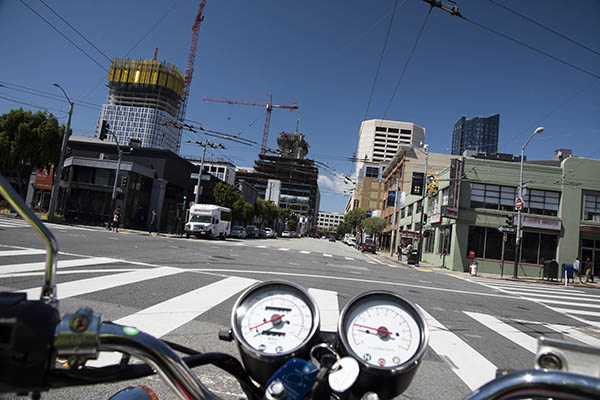
I didn’t take the G400c on the freeway, although Barry invited me to do so. Nope, the freeways are typically a mess in San Francisco, and I figured (correctly, as I experienced on the drive out of San Francisco later in the day) I could actually get more miles in and reach higher top speeds on the city streets. And I did. Until this guy you see in the photo caught up with me, lit me up, and started casting dirty looks my way. Then he got in front of me. Point taken, Officer. I rode a bit more like a normal person after that.
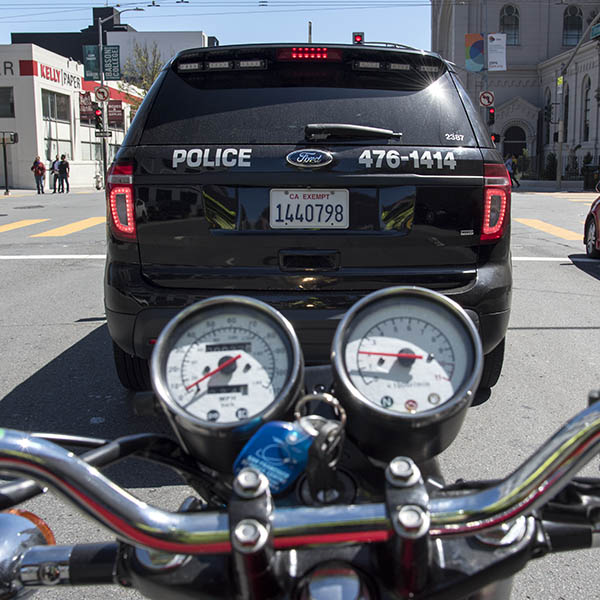
Okay, let’s not ignore the 800-lb gorilla in the room: The G400c is manufactured in China. As many of you know, I know a little bit about Chinese motorcycles and I played a tangential role in making the case for Chinese quality when CSC Motorcycles started importing the Zongshen RX3 back in 2015. You might have trepidations about buying a Chinese motorcycle, and it’s almost a certainty you know people who badmouth Chinese products. My advice when you hear the inevitable anti-China mush is to remember that God loves stupid people (because He sure made a lot of them). Yeah, they’ve got their stories about their buddy who worked at a dealer 10 years ago and he told them…well, you get the idea. Folks, these people just don’t know.

My advice is to blow these weenies off, get yourself to a dealer, and see for yourself. I know a little bit about quality and manufacturing, I’ve been in several Chinese manufacturing plants, and I’m here to tell you that Chinese motorcycle quality is as good as or better than anything that’s out there. Consider this: Automobile and motorcycle companies like BMW, Vespa, Honda, Suzuki, and many others have components, major subassemblies, engines, and complete motorcycles manufactured in China. These world-class companies wouldn’t be doing that if the quality was low.
You might have a concern about the G400c being a new bike, that is to say, one that doesn’t have a track record. Actually, that’s not the case. This motorcycle has been rolling around China for a good three years now (I saw them when I rode across China on the RX3 a few years ago). The G400c is manufactured for Genuine by Shineray (it’s pronounced Shin-yu-way), and in China, they have been selling two versions of the bike for several years (a street version and an adventure-touring-styled version). The riding in China is way tougher than it is here. We tend to use our motorcycles as toys. In China, motorcycles are work horses. They are ridden hard and put away wet.
Another thing that’s nice about the G400c motor is that it’s a Honda clone. The concept (but not the engine) here is the same as the Honda CG clone motors that power the CSC and Janus bikes…an engine based on a Honda design built for an environment where folks don’t take care of their bikes. It’s a different Honda motor design, but it’s a proven design. It’s a strong, torquey, fuel injected single.
The G400c’s braking is good. It’s a single disk in front, and a drum in the rear. A lot of folks will be grasping their chest and convulsing at the thought of a drum brake in back, but it works, and it works for me. Again, don’t let some kid writing a magazine article (or worse, someone posting an opinion on Facebook) tell you that you have to have a disk brake in back. Drum brakes have worked fine for decades. It’s one of the things keeping the cost down on this bike, and it’s a reasonable tradeoff. Like it said, it works for me.
What I don’t know yet is the parts availability question, nor do I know about the availability of a shop manual. Those are fair questions to ask a dealer. I didn’t, mostly because I was focused on the riding.
Genuine states the top speed is over 80 mph. I’ve ridden bikes with the same engine in China and I saw indicated speeds on city streets over 90 mph and the bike still had more left (and at that point I thought to myself “Whoa, Bucko…what am I doing here?”). I think the top end is more than adequate for any real world needs. And on that note, this is another area in which you hear the keyboard commandos espouse things like “Ah need a bike made in ‘Merica that can do at least a hunnert twenty miles per hour or I’ll get run over…” You do, huh? Hey, I rode across China, I’ve been up and down Baja a bunch of times, I circumnavigated the Andes Mountains in Colombia, and I’ve ridden all over the US. And I did all of this on 250cc motorcycles. Motorcycles made in China, to be specific. But what do I know?
You might ask: Are there any negatives? I guess to play magazine road test writer I have to find something, and on the G400c it might be that some of the details could be more finely finished. Maybe the handlebar switchgear castings could be polished a little more, things like that. Barry told me the bike I rode is one of the very earliest ones to arrive in America, and that Genuine is sweating the cosmetic details like this. But these are minor points. The next question would be: Would I recommend buying this bike? To that question, the answer is yes. They retail at about $4600, and with all the fees they go out the door at a notch above $5700. Barry is one of the few honest dealers I know in that he doesn’t treat setup and freight as a major profit center. Here’s how he has the bikes priced…
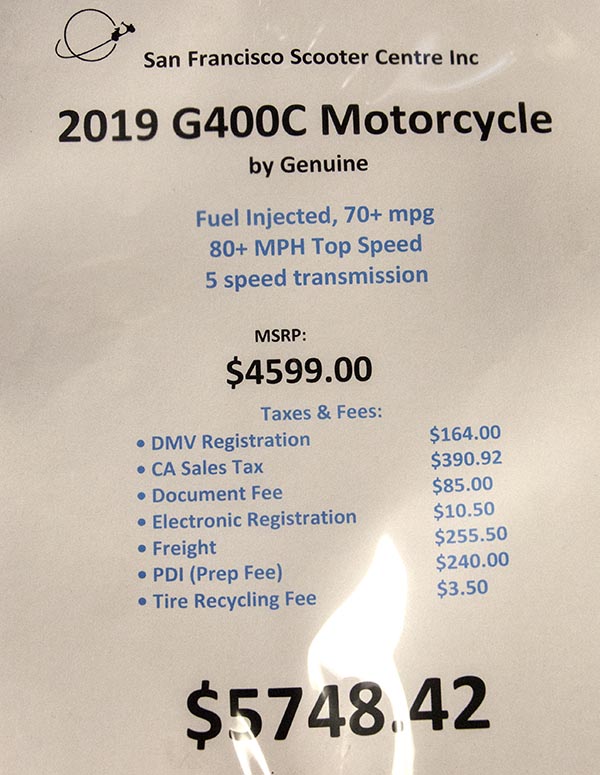
We are living in interesting times. Just a few years ago the small motorcycle landscape in the US was pretty barren, and what few bikes were out there carried stupid-high prices and obscene dealer freight and setup fees. Our choices in recent decades have been outrageously tall, fat, and heavy motorcycles with prices in the stratosphere. Today, the moto menu before us is interesting and intriguing, and it’s rooted in the real world. There’s the CSC Motorcycles line with several 250cc selections and soon, the 450cc RX4. There the Janus line of magnificently-handcrafted contemporary classics. There’s Royal Enfield, with their 400cc Himalayan, 500cc Classic, and soon-to-be-released 650cc Interceptor (at an incredible $5795). I’ve ridden nearly all of these motorcycles (I haven’t caught a ride on the Himalayan yet, but that’s coming up), and I’ve ridden many of them through Baja (you can read about our Enfield Baja trip, the Janus Baja trip, and any of several CSC Baja trips). And now, there’s another great bike in the mix: The Genuine 400c. For the first time in a long time, we have choices. Good choices that won’t break the bank. Life is good, folks.
Check out our related Genuine G400c and San Francisco Scooter Centre posts!

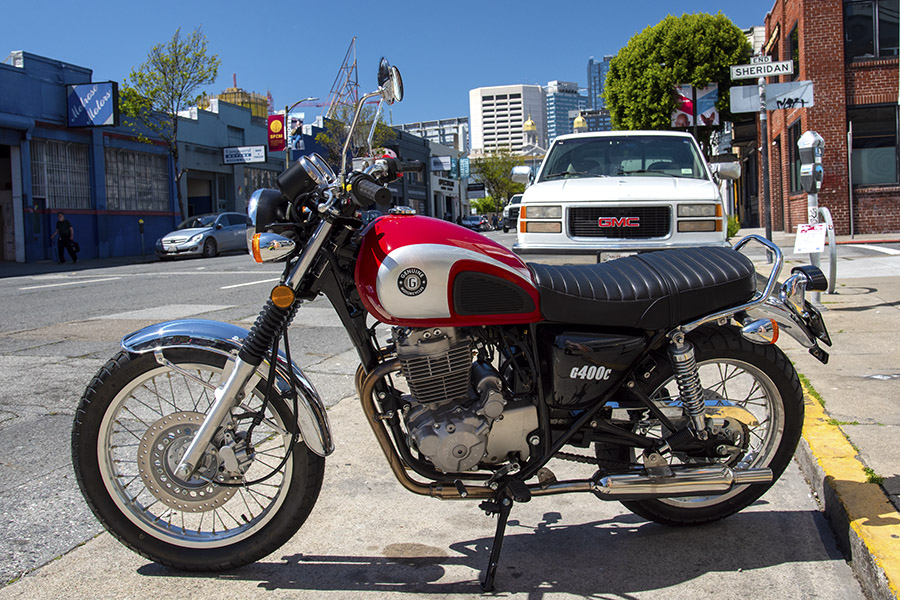
I’ve never understood why Chinese manufacturers have American importers rename their motorcycles.
It may be a liability thing, as in the buck stops at the importer.
Still, it keeps them from building brand recognition and buyers are less trusting because of the brand shenanigans.
Maybe Joe Berk can shed some light on the reasoning.
It’s a mystery to me, too, Joe. When I was at CSC, we first promoted the RX3 as a Zongshen motorcycle with the Zongshen emblem. The folks at Zongshen were miffed that we did that (it never occurred to us that it should be marketed as anything else). Zongshen informed me that they allowed use of the Zongshen name only in certain countries. So, we branded it as a CSC. Man wants a blue suit, you install a blue light bulb. I don’t know what the particulars are with Genuine and Shineray, but I would imagine that Genuine wanted/preferred to market the bike under their own name. It’s what we would have preferred at CSC, too, but we initially (and mistakenly) went with the Zongshen name because we were being deferential and I never thought to ask if we could market it as a CSC. That’s what Zongshen wanted CSC to do, though, and that’s why it’s a CSC today. Elsewhere in the world, the RX3 is marketed under many other names. I’d want them all to be called Zongshens, but these folks evidently know what they are doing. I don’t build a million motorcycles a year; Zongshen does.
Cool bike and the pup is awesome.